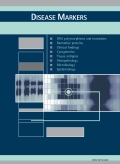Authors: Wu, C.H. | Lin, S.R. | Hsieh, J.S. | Chen, F.M. | Lu, C.Y. | Yu, F.J. | Cheng, T.L. | Huang, T.J. | Huang, S.Y. | Wang, J.Y.
Article Type:
Research Article
Abstract:
Early detection of disseminated tumor cells in the peripheral blood of patients with early stage gastric cancer could help to improve the outcome after tumor resection. The aim of this study is to evaluate the prognostic significance of tumor-related mRNA for the detection of circulating tumor cells in gastric cancer patients by a reverse-transcriptase polymerase chain reaction (RT-PCR) method. We simultaneously analyzed human telomerase reverse transcriptase (hTERT), cytokeratin-19 (CK-19), cytokeratin-20 (CK-20) and
…carcinoembryonic antigen (CEA) mRNA (messenger RNA) expression in the peripheral blood of 42 gastric cancer patients and 30 healthy individuals. Additionally, analyses were carried out for the correlation of these four molecular markers with patients' clinicopathologic features, as well as the occurrence of postoperative recurrence/metastasis. Among 42 gastric cancer patients, the prevalence of mRNA for hTERT, CK-19, CK-20, and CEA was 61.9% (26/42), 69% (29/42), 61.9% (26/42), and 78.6% (33/42), respectively. All 30 healthy individuals were negative for hTERT and CEA mRNA, while two were positive for either CK-19 mRNA or CK-20 mRNA. Positive CEA mRNA was significantly correlated with tumor size p=0.008), vessel invasion (p=0.001), depth of tumor invasion (p=0.007), lymph node metastasis (p< 0.001), and TNM stage (p<0.001). In addition, the multivariate logistic regression demonstrated that CEA mRNA expression was an independent and significant predictor for postoperative recurrence/metastasis (p=0.032). Our findings suggest that CEA mRNA may be a more reliable marker than hTERT, CK-19 and CK-20 for the detection of circulating cancer cells in gastric cancer patients' peripheral blood. Patients with positive CEA mRNA expression in peripheral blood have a significantly higher risk of postoperative recurrence/metastasis.
Show more
Keywords: Molecular detection, disseminated tumor cell, gastric cancer, CEA mRNA
Citation: Disease Markers,
vol. 22, no. 3, pp. 103-109, 2006
Price: EUR 27.50





